Rivers in currents
Main components of the river community

As for the primary producers of the river, algae, mosses and phanerogams are abundant. Fluvial dominant algae are microalgae of the epilith of stones (layer formed by algae, fungi, bacteria, microinvertebrates and detritus), in which there can be chlorophylls, cyanotrades, feofeos, baciles (diatoms) and rhodophyceans. In these algae two types are distinguished: some (such as chlorophyte Cladophora or rhodophyte Lemanea) form firucas colonies in medium current zones and others (diatoms such as Navicula and Gomphonema) in the form of free cells or flat colonies (e.g. We found rivularia rodofita). This last group can prevail in hard currents, but they often also settle on a powerful colony.
Mosses have a stricter distribution in rivers, unlike other plants that use CO 2 as a source of carbon. For this reason, in the springs loaded with CO 2 and in the surroundings of the waterfalls predominate the mosses called Fontinalis. These are able to adhere to the stones and can overcome the toughest currents. Therefore, it is the fastest areas that abound the most, settling mainly in the large stone blocks. Most of the importance of moss communities can be seen in the nacederos of karst areas, where they help precipitate lime, forming the type of limestone known as travertine, as can be seen in Urederra.
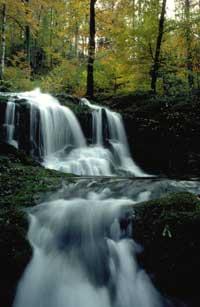
We know them as macrophytes. Ranunculus, Potamogeton, Miriophyllum, Rorippa, etc. are some of the genera that we find in the rivers of Euskal Herria. All these roots require a sandy or clayey background, so they predominate in slow areas. The main function of the roots is usually to attach them to the substrate, since most of the food comes from the leaves. Because they are terrestrial plants, they have reproductive problems, since most are entomophilous species (that is, insect pollinators).
Therefore, vegetative reproduction is the most common, while for sexual reproduction, most parts of the plant are submerged, so the flowers must be in the air, limiting the maximum depth in which they can live. To combat flooding, on the other hand, they have extensive and deep radical systems, and with a mainly perennial life cycle. The distribution of macrophytes in the river is constantly changing due to sedimentation and erosion, the main adaptation being vegetative reproduction.
Finally, only in very slow rivers can we find a real phytoplankton and floating vegetation, since in other cases they are transported downstream. Among the floating ones is the typical water lentil ( Lemna minor) and the nenufar ( Nuphar lutea), typical of temperate regions.
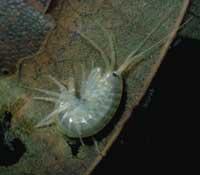
In the case of animals, the microfauna composed of rotifers, microarthropods, etc. is abundant in sediments, but the best-known groups are macroinvertebrates. It consists of crustaceans, platihelmines, molluscs and especially larvae and adults of many groups of insects. Among the crustaceans, the amphipod Gammarus is abundant in places where the crunch accumulates, the isopod Asellus in slow currents, and the crab of river Australopotamobius in most high and middle areas, feeding mainly on massacres. As for insects, group larvae with flying adults can be found in the river. Among these are plekopteros, efemerópteros, dipteros, odonatos and tricópteros. In other groups, both larvae and adults are aquatic. This is what happens with several coleoptera and hemipteros.
All these animals have similar problems to live in the rivers: low flow rises alter the size of the habitat in which they live, transport the currents down and are exposed to numerous predators. However, they have developed very different mechanisms to address these evolutionary pressures, which explains the uniqueness of these communities.
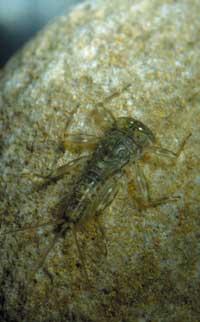
If each species is kept in the area that suits you, therefore, you should look for ways to cope with the current. Among them, the most common is the hydrodynamic soda form. Therefore, most efemeropters and plekopters have slender bodies specially adapted to the pattern of water circulation on stones. Heptagenid ephemeropters are also flat, as the force of the current decreases considerably against stones.
The strategy of the trichoptera is very different: these insects, in addition to offering protection to their predators, manufacture and protect stone covers that function as ballast. However, in all these insects downward transport is inevitable, so flying adults always roam the river by spawning eggs. Many other invertebrates, such as cymbals, seek the protection of the current under stones, for which they usually have flat and flexible bodies that penetrate the air through the slits. Avoiding current is not possible for simulated diptera living by filtering water.
These always look for areas of the toughest current, where they are tied to the stones thanks to their key crown on the back. Although a blow of water drives them out of their place, they are tied with silk thread, and the mountaineers, like their protective rope, use it to return them.
Obtaining oxygen in fast races is not difficult and many of its inhabitants (e.g. plekopteros) have very small gills. In the slower rivers, this can also become a problem, which implies greater gills. This is the case of Ephemerella, for example. However, there is a risk of collapsing the gills with the sediments that accumulate, and other animals predominate in the sandy bottom zones: the discid coleoptera that carry an air bubble that functions as a lung in the gluteal region, or the chironomide diptera that can be found in sediments with low oxygen content. The latter have very high hemoglobin concentrations to combat oxygen shortage, which gives them their typical red color.
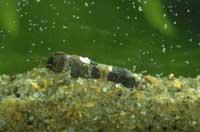
River animals rely heavily on land materials and have not been able to develop strict specific relationships such as terrestrial insects with specific plant species. Therefore, their diet is more varied, usually depending on their way of feeding, classifying them into different functional groups.
One of these functional groups is the filter. These animals passively collect the fine particles transported by water (less than 1 mm. ), so the areas with the highest concentration of particles and relatively high currents are the most abundant.
The filterers are simulated that filter the water with branched jaws, or the Hydropsiches tricopters that build conical silk nets under the stones. There are also active filters such as the Margaritifera bivalva that pumps water, especially in large rivers with a large amount of organic particles and plankton. Collectors of fine particles accumulated in sediments are fed. In them two groups can be distinguished: some (for example, oligochets) are sedimentary and others actively select particles (for example, Baetis ephemeropters). In areas where much baked accumulates predominate dividers that feed on large particles. These include the Gammarus crustacean or the aforementioned Sericostoma tricopter. Feeding on the periphyte of the rock we find rubbers such as heptagenid efemeropters or gastronopod mollusks. And of course, wherever there are hunting pieces, dams such as dental larvae and the Perla plekoptero.
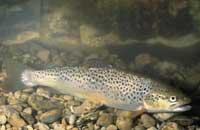
Feeding on these rich communities of plants, microbes and invertebrates, as could not be otherwise, we have different communities of vertebrates. First, we will mention the fish. Their communities are separated by the river gradient. Therefore, in the first fast and cold areas of the river is the region of trout. Trout predominates in it ( Psalm trutta), but we can also find salmonids such as Salvelinus, thyme ( Phoxinus phoxinus) and numerous benthic fish. The latter are more flat and adhere to the substrate by suction cups or fins.
When the waters begin to inert, we enter the region of the barbs. Cyprinids predominate here, such as barbs ( Barbus sp . ), plants (Chondrostoma sp.) or gobies (Gobio sp. ). In very slow rivers the region of the bream ( Abramis brama) is distinguished, among whose species we find the tenca ( Tinca tinca), the zamoa ( Cyprinus carpio), etc. Many of these fish are terrestrial, but they can carry out large breeding migrations across the river.
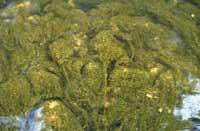
Most species in the trout region nest in fast, cold and clean areas where eggs are laid. Those in the Brema region, however, do so in areas with abundant vegetation. However, there are still other species that carry out longer migrations, carrying out parts of life in rivers and others in the sea. In them we find anadromes like salmon (Psalm salar), which reproduce in the river and live in the sea, and catadromes like the eel (Anguilla anguilla), which reproduce in the sea. Their migrations are surprising both for the length of the trip and for the difficulties they have to overcome.
Birds also reflect the zoning of the river. In the higher areas, the water blackbird ( Cinclus cinclus) is immersed in search of invertebrates, and from the banks the potters ( Motacilla sp.) It feeds on jokes ( Actitis macularia). Fed fish, kingfisher ( Alcedo athis) and saw ( Mergus sp.) or ducks with algae ( Histrionicus histrionicus). In the inert rivers, on the other hand, the heron ( Ardea sp.) The Amiltxoris ( Nycticorax nycticorax) are the main ictiosfos of the shore, the large carpenters ( Podiceps cristatus) among the submarines and feed on numerous species of duck with plants and invertebrates.

Most of these birds have their mammal pairs. For example, in the fast rivers the aquatic mole feeds on submarine invertebrates ( Galemys pyrenaicus), being the majority ichthophagus the otter ( Lutra lutra), along with the mink ( Mustela lutreola) and the turón ( Mustela putorius). Water rat among herbivores ( Arvicola sp. ), the beaver ("Castor faber"), and today we have a tale ("Myocastor coypu") that is causing so many headaches. In the largest rivers in the world there are dolphins and manatees.
Functioning of river communities
The river communities, as has been seen, are formed by cosmopolitan species with great colonizing capacity. Flow fluctuations cause continuous stress in these communities, which must be in full transformation, but with great flexibility and resilience.
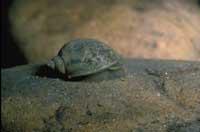
To overcome the loss of copies transported by the current, invertebrates must have a high reproduction rate and a high dietary adaptability, which necessarily leads to a low competitive capacity or the absence of honeys and poisons or similar protective mechanisms so abundant in terrestrial insects. Beings that present a rapid ecological life cycle, a high birth rate, a great capacity for dispersion and colonization, a wide ecological tolerance and a low competitive capacity are known as r strategies, of which several river species can be cited. Floods and droughts have been the main factors of species evolution in rivers, so it is not surprising that their communities are highly adapted to recolonization.
Coupled with this great colonization capacity, and although until recently it was thought otherwise, rivers are areas with a very high metabolism. Due to the continuous renewal of water, despite the low concentration of nutrients, algae can maintain a very high production rate in treeless rivers, while in undergrowth microbial communities quickly break down the organic matter that arrives, being the main source of energy fungi and bacteria for animals.

This biological activity can also influence the abiotic conditions of the river, and for example, the concentration of oxygen and pH can suffer ups and downs throughout the day, especially in the medium food-rich rivers. The river community, therefore, regulates to a certain extent the conditions of its environment and possesses a great capacity to process organic matter and inorganic nutrients, that is, to self-purify them. Besides orienting the export of the communities of the terrestrial zone towards the sea, they are zones of great activity and, therefore, better natural depuradoras.
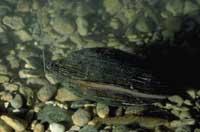
The physical-chemical gradients of the rivers offer very different habitats along their route, resulting in a remarkable zoning of the communities. Although these distinctions occur continuously, the living beings of the main areas located in a river of the Basque Country and the functioning of the communities that form them would be the following.
Sources

In most of the rivers of Euskal Herria the spring is in the montane strait. As a result, the forest surrounds the river and the shade of the trees prevents the appearance of numerous peripheries and macrophytes. In case of finding them, we will find the rhodophyte Rivularia and the moss Fontinalis. The main source of energy of the river is the horvela coming from the coast, so we have a heterotrophic community, where more is consumed than produced. Among invertebrates, plecoptera and splitting efemeropters predominate, and in areas where the substrate is calcareous, Gammarus crustaceans. The most representative vertebrates are aquatic myrtle, mole water and trout.
Medium streams

A few kilometers from the spring (in the zones of 4 to 6 orders) the river has expanded and this width makes it reach more light to the bottom, being able to begin to dominate the algae (especially in calcareous streams rich in nutrients or with agricultural areas in the basin). Invertebrate communities also vary greatly: splitters lose importance and scrubbers that feed on algae or seepants that feed on fine particles transported from the spring multiply. In addition to trout, we find barbs. These communities can be autotrophic, that is, produce more than is consumed in them, directing the excess of organic matter to the lower zones.
Small rivers
In the rivers of order 6 to 8 the depth has increased considerably and the current has been reduced. This can cause the presence of macrophytes (in the Basque Country the Miriophyllum is very abundant) in the background and as far as fauna is concerned, catchers and filtering predominate. Fish densities (especially cyprinids) are the highest, and for mammals and birds that feed on them, it is an appropriate place.
Great rivers
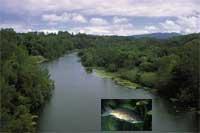
Due to their great depth, there is no light in the background, so there are no benthic producers. Floating vegetation and plankton can be important. However, these rivers are heterotrophic, as their main source of energy is fine particulate matter from above. The main types of invertebrates are the filtrants (among them several planktonic beings) and the sedimentary ones, and between the vertebrates the fishes of inert waters. The irrigation plains on the banks of the river are of great importance, as well as the basements or gallery bushes that are installed in them.





